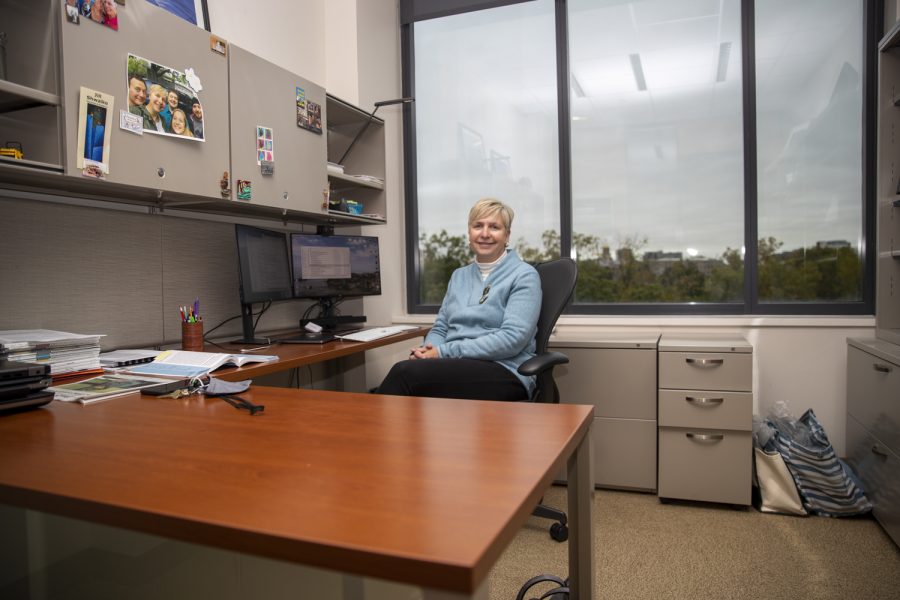UI-based center receives $6 million to improve worker health
The Healthier Workforce Center of the Midwest has been renewed for a fourth five-year cycle to continue research, education, and outreach to companies and improve workplace mental and physical health.
Director of the Healthier Workforce Center Diane Rohlman poses for a portrait on Thursday, Oct. 21, 2021. (Jerod Ringwald/The Daily Iowan)
October 21, 2021
The Healthier Workforce Center of the Midwest, a University of Iowa-based program, has been awarded renewed funding to improve workplace health and well-being throughout the region over the next five years.
The center is one of 10 Centers of Excellence for Total Worker Health around the country and is funded by the National Institute for Occupational Safety and Health. Total funding is expected to exceed $6 million.
Diane Rohlman, director of the center, said the center focuses on research, education, and outreach to improve worker wellbeing.
“We develop short videos and podcasts,” Rohlman said. “What we do is we take science, and we translate it into tools that employers can use.”
Rohlman said the Healthier Workforce Center was founded in 2006 and works with partners in Iowa, Nebraska, Missouri, and Kansas. She said the center is funded by the National Institute of Occupational Safety and Health for five years at a time and focuses on research and a pilot program.
“Depending on what funds are available, we propose different projects,” Rohlman said. “What’s kind of interesting is we do have a pilot grant program, where we have small amounts of money for people to apply for.”
She said the center looks to grant money to employers, community partners, or students for research projects that look to improve workplace well-being.
Much of the funding will go to four projects within the center, Rohlman said, including one project researching the maximization of remote worker and supervisor productivity. She said another project will focus on improving worker well-being in nursing homes, which can be physically and emotionally taxing.
Rohlman said two of the four projects will focus on aspects of the construction industry – suicide rates and opioid use – which are often overlooked and have lacked any scientific research.
Bradley Evanoff is an associate director of the UI center and a professor of occupational, industrial, and environmental medicine at Washington University in St. Louis. His research at the center focuses on suicide rates among construction workers.
“Suicide actually kills five times more construction workers than do workplace injuries,” Evanoff said. “This has become a major focus of the construction industry as attention is starting to turn to mental health issues in general and suicide rates in particular in the industry.”
Evanoff said the relationship between the center and the construction industry has developed over time. He said the center originally coordinated with the industry to study high injury rates.
As the relationship between the two strengthened, Evanoff said, researchers began listening to issues construction companies were having and that led him to this research.
In the previous round of funding, Evanoff said research from the center was looking at factors in the construction industry that were causing higher injury rates, more stress, and higher rates of opioid use.
“That project basically helped lay the groundwork for what we’re doing now,” Evanoff said. “We’ve pivoted, in the next five years, to trying to look at ways to change those organizational factors and make an effective intervention to improve mental health and decrease suicide rates.”
Ann Marie Dale, professor of medicine at Washington University and center researcher, said her work focuses more on opioid use and addiction problems among injured workers. She said this funding will allow her to work with contractors to develop useful and understandable programs.
“When they do develop pain and discomfort and they go to the doctor, they have more recently been treated by prescription opioids,” Dale said. “This is one thing that has contributed to opioid addiction among construction workers.”
The outreach will attempt to teach workers about the risks and addictiveness of opioids, Dale said, as well as educate supervisors on the danger of opioid use on the worksite. The outreach will also encourage employees to seek professional support earlier rather than later.
Dale said outreach will be facilitated through her connection with the Healthier Workforce Center of the Midwest. She said the center allows her research to be expanded across the other three states while also more broadly distributing her findings and potential interventions.
“Being in the area of ergonomics and health and safety, it’s a pretty small world, believe it or not,” Dale said. “It was logical if we are working in this space that we can combine our efforts and cover a larger region of the country and provide total worker health services to a broader area.”



